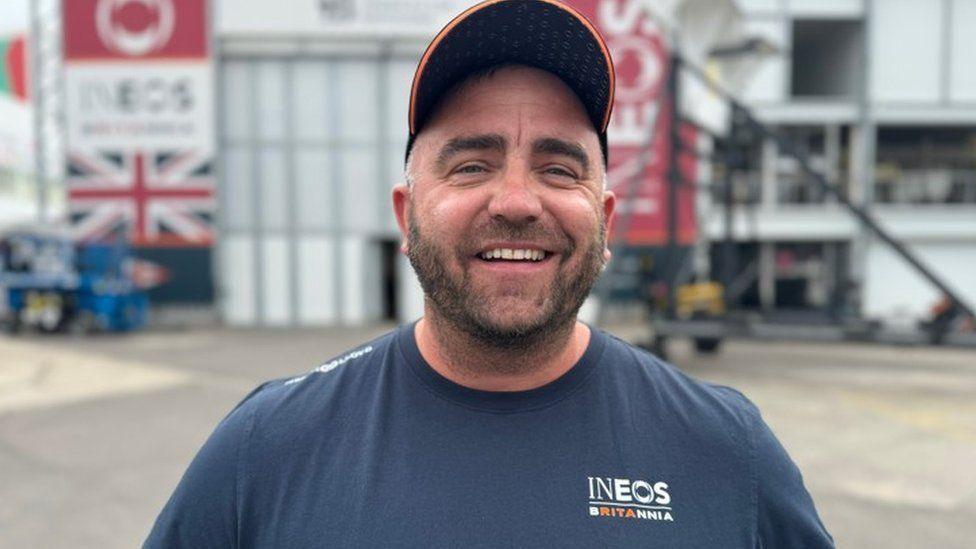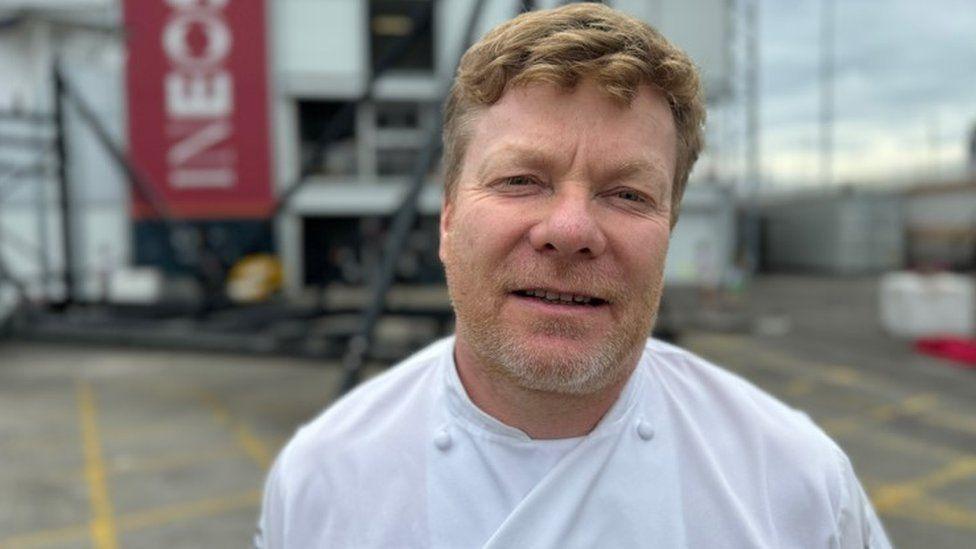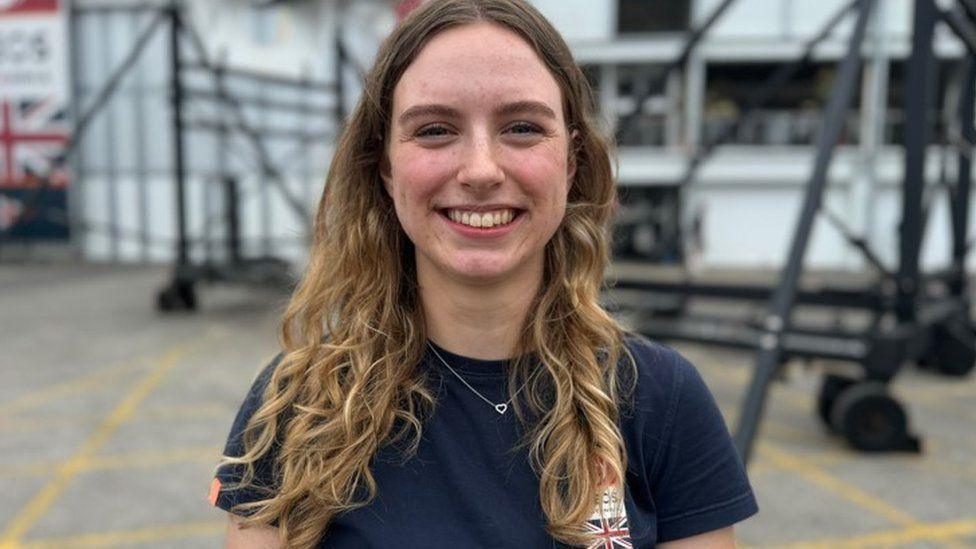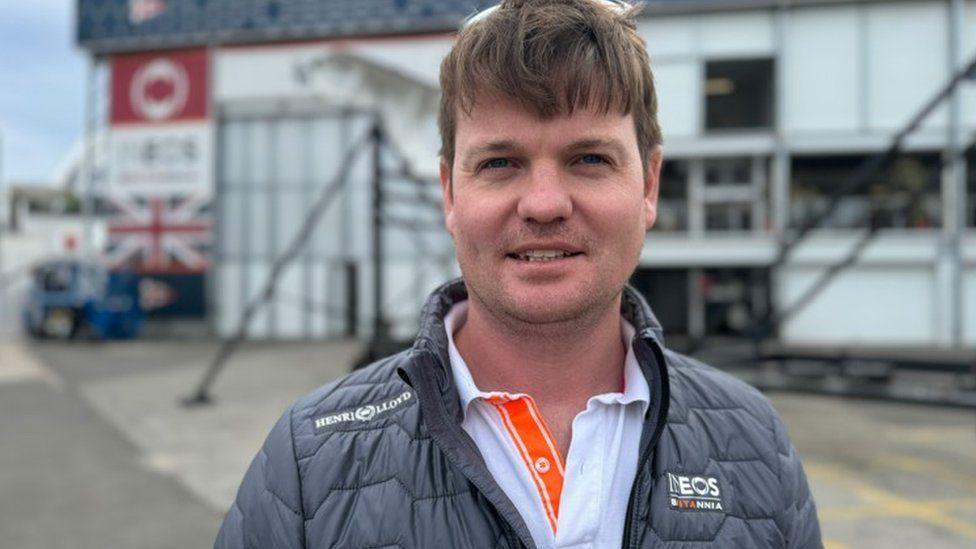Ineos Britannia: The team behind the team

Ben Ainslie's Ineos Britannia team in action off Barcelona
- Published
The America's Cup is seen as the pinnacle of yacht racing, the world's oldest sporting competition that continues to be the 'Holy Grail' for a British team that's never lifted the trophy.
While the focus understandably turns to the eight sailors onboard INEOS Britannia each race, the British challenge is built on a foundation of teamwork behind-the-scenes, with over 150 people working towards the same goal.
The team headquarters is based in Brackley, west Northamptonshire, but has relocated to a temporary home in Barcelona for the past 16 months, including many people from the south of England.
Let's meet some of the team behind the team.
Jamie Scott, crane driver, Reading

Ineos Britannia's AC75 foiling race boat weighs 6.2 tonne. When not sailing it is stored inside the team's base in Barcelona.
Jamie's job is to calmly manoeuvre the boat out of the hanger and on to the water using a remote-controlled crane.
He said: "The first few were a bit nerve wracking but we've got it down to an art now and have done it about a hundred times.
"It takes about half an hour. We roll it out, mast on, in the water - it's pretty quick. I use two joysticks, it's just like a PlayStation.
Nick Holt, team chef, Portsmouth

Nutrition is a key part in maximising the team's performance. Not only for the large on-shore team but, in particular, for the sailors tasked with elite physical performance on the water.
For example, the hydraulic power to trim the sails and make the boat go faster is produced by Cyclors who must maintain up to 500+ watts on a static bike for spells of 20 minutes.
Nick's role is to fuel the sailors.
"We do anything up to eight meals or snacks a day for the team here. Starting with breakfast at around 07:30 and then various meal sittings throughout the day, as well as snack boxes and energy bars to take out on to the water during training.
"I work closely alongside the head of performance and try and come up with protein bars, energy balls and shakes, for example, to help fuel our sailing team.
"It's constant feedback. They have their favourites and I know what their favourites are so, on a race day, we try and give them what they like."
Ana Paterson, reliability engineer, Brackley

Ineos Britannia's boat has 120,000 individual parts that took 50,000 hours to build. That's a lot of components that could potentially go wrong.
The balance between reliability, optimum performance and durability is an ongoing discussion in the design process and development.
Ana's job is about making the boat as reliable as possible when it's out on the water.
She said: "There's so much that can go wrong in a boat as complicated as ours, such as hydraulic failures, electrical failures, corrosion, water ingress and any number of those things could stop you on a race day and lose you a point.
"My job is a jack of all trades. I have to communicate with all members of the team across all disciplines in order to understand exactly what's going on. I studied Marine Engineering and Naval Architecture at University and was inspired to do so by watching the America's Cup growing up."
Tom Cheney, performance software engineer, Portsmouth

Sporting performance in the America's Cup is largely driven by data. There are 700 sensors and channels on board, alongside 33 cameras relaying information back to the data analysis team that then guides the decision-making process of the shore-based support team.
Tom is one of the Performance Software Engineers.
"My role is incredibly data driven, incredibly geeky and technical," said Tom.
"We get so few days actually sailing against our competitors. We spend two of the four-year cycle out sailing on our own, trying to work out if what we've designed is fast and eek the most performance out of it.
"Then you enter the racing period and you get to see what you're racing against and you get a little bit of their data as well to try and analyse the performance and ideally, with all that information, make our boat go faster."
The remaining races of the America's Cup will be available to watch live on BBC iPlayer, the BBC Sport website and app, with Saturday's racing starting from 13:00 BST.
Get in touch
Do you have a story BBC Hampshire & Isle of Wight should cover?
You can follow BBC Hampshire & Isle of Wight on Facebook, external, X (Twitter), external, or Instagram, external.
Related topics
- Attribution
- Published18 October 2024
